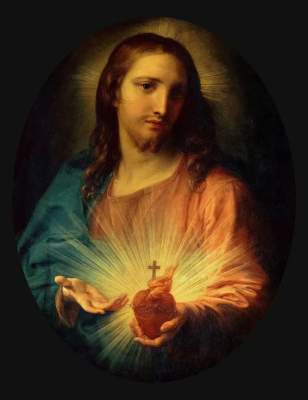Gospel in Art: For it is from within, from men's hearts, that evil intentions emerge

Sacred Heart of Jesus, by Pompeo Batoni © Church of the Gesù, Rome
Source: Christian Art
Gospel of 8 February 2023
Mark 7:14-23
Jesus called the people to him and said, 'Listen to me, all of you, and understand. Nothing that goes into a man from outside can make him unclean; it is the things that come out of a man that make him unclean. If anyone has ears to hear, let him listen to this.'
When he had gone back into the house, away from the crowd, his disciples questioned him about the parable. He said to them, 'Do you not understand either? Can you not see that whatever goes into a man from outside cannot make him unclean, because it does not go into his heart but through his stomach and passes out into the sewer?' (Thus he pronounced all foods clean.) And he went on, 'It is what comes out of a man that makes him unclean. For it is from within, from men's hearts, that evil intentions emerge: fornication, theft, murder, adultery, avarice, malice, deceit, indecency, envy, slander, pride, folly. All these evil things come from within and make a man unclean.'
Reflection on the painting
In our Gospel reading today, Jesus talks about the human heart. Less than a week away from Valentine's Day, we see many depictions of hearts all around us this time of year. The heart shapes are the popular depictions of love, especially of romantic love. In our Gospel reading, Jesus is, however, talking about the true and more wholesome meaning of our human hearts. He states that the human heart is the very inner core of the person. That core can have both light and shade; it can be a source for good and for harm. By the way we live our lives, we can fill our hearts with good things, or we can let badness creep in as well.
One of the great traditional Christian images in art is that of the Sacred Heart of Jesus. Many of us may have grown up with an image of the Sacred Heart in our homes. These depict Jesus showing off his own heart, so that we as a viewer may follow his own heart. Our calling is to have hearts that reflect the Sacred Heart, to have an inner core that partakes in God's inner core.
An early version of such a Sacred Heart painting is our artwork by Pompeo Batoni from 1767. Christ is shown wearing a red tunic, which represents the colour of blood, martyrdom and humanity; and a blue mantle which symbolises the colour of heaven and Christ's divinity. Jesus is holding in his left hand an inflamed heart crowned with thorns and with a cross at the top. Batoni's painting immediately gained popularity and became the official image for the devotion to the Sacred Heart of Jesus.
Batoni was born 18 years after the death of Saint Margaret Mary Alacoque, the saint who inspired the artists of all Sacred Heart of Jesus portraits. Jesus appeared to Saint Margaret Mary, who described the encounter in this way: "The Divine Heart was presented to me in a throne of flames, more resplendent than a sun, transparent as crystal, with this adorable wound. And it was surrounded with a crown of thorns, signifying the punctures made in it by our sins, and a cross above signifying that from the first instant of His Incarnation,... the cross was implanted into it." This painting is still placed above the altar in the northern side chapel of the Church of the Gesù in Rome.
LINKS
Gospel in Art: https://christian.art/
Today's reflection: https://christian.art/daily-gospel-reading/mark-7-14-23-2023/


















